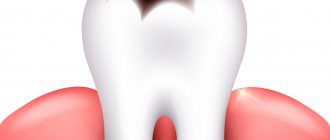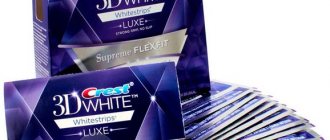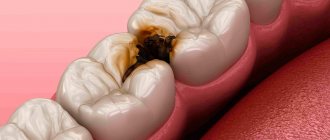Indications for remotherapy
Tooth enamel is a kind of crystalline network up to 2 mm thick, consisting of 96% inorganic compounds. The porous structure of this hard shell of the tooth allows acids and enzymes contained in food and saliva to penetrate into it. Under the influence of these aggressive substances, some of the minerals in the enamel dissolve, the tooth shell becomes thinner and loses strength.
Remotherapy is used to eliminate defects that have arisen due to a deficiency of mineral components in tooth enamel, in order to strengthen it, and also as a means of caries prevention. It is indicated for:
- hypoplasia (congenital underdevelopment of enamel);
- enamel damage (erosion, microcracks, chips);
- hyperesthesia (increased sensitivity) of teeth;
- superficial caries;
- change in enamel color;
- during the recovery period after long-term wearing of orthodontic appliances;
- as a preparatory procedure before teeth whitening;
- to stabilize the result after teeth whitening.
Why does tooth enamel need remotherapy?
Tooth enamel has a prismatic structure consisting of hydroxyapatites, fluorapatites and other crystalline formations. Also, enamel contains various chemical elements and organic substances. There is a constant exchange between tooth enamel and human saliva: normally, saliva enriches the enamel with various substances necessary to maintain the integrity of the structure of enamel prisms.
If the pH of saliva, its mineral composition, quantity or consistency changes for any reason (the characteristics of saliva are affected by taking certain medications, cariogenic situation in the oral cavity, chronic diseases, smoking, pregnancy, etc.), this immediately affects condition of tooth enamel. The original components of the enamel structure begin to gradually wash out of it. Next, bicarbonate ions, hydrogen ions, and strontium ions are introduced into the enamel. They replace calcium, phosphates and fluoride, disrupting the optimal chemical composition of enamel hydroxyapatites and making it vulnerable. After some time, a carious lesion in the form of a white spot may appear on the demineralized enamel, or the person will begin to suffer from dental hypersensitivity. A timely course of remotherapy will help normalize the composition of the enamel and get rid of the consequences of its demineralization.
Design and principle of operation of aligners
A dental tray for remineralization therapy is a removable lining made of safe plastic materials - silicone or polyurethane of varying thickness and hardness. Using this orthopedic device at home is very simple. The aligner is filled with a preparation for remineralization, and in this form is put on the jaw. Thanks to its hermetic design and precise fit to the shape of the dentition, the mouth guard adheres well to the teeth, and its therapeutic contents gradually enter the dental enamel tissue, saturating them with minerals.
Standard preparations for remineralization contain a balanced set of fluorine, phosphorus and calcium compounds (calcium gluconate, phosphate or glycerophosphate). The following gels are considered the most effective for reminalizing therapy:
- Tooth Mousse (manufacturer - Japanese company GC);
- Remineralizing (manufacturer - OCS company, Russia);
- Medical Minerals line with various additives (ROCS, Russia);
- Zahnreparatur Gel (manufacturer ApaCare, Germany).
To ensure the best effect of the drugs placed in the aligner cavity, it is recommended to wear it 10-12 hours a day. The duration of the course of remotherapy is determined by the dentist; it depends on the type of enamel damage, and usually ranges from several weeks to several months.
Remineralizing therapy.
Teeth are living organs with metabolic processes constantly occurring in them.
Many people have probably heard more than once about such a phenomenon as the acid-base balance, which must be restored every time after eating. This is explained by the fact that the pH in the oral cavity becomes acidic after eating. To neutralize this condition, the process of “washing out” microelements from tooth enamel into the oral cavity begins to become more active. This process is called demineralization; if it becomes dominant over the processes of remineralization, then defects appear in the enamel, which subsequently open the way for the development of caries. This is a pathological process in which the hard tissues of the teeth soften with accompanying demineralization. A cavity gradually forms in the tooth. The development of caries can be influenced by external and internal causes. It is characterized by the following stages:
▪ Stains.
▪ Superficial.
▪ Average.
▪ Deep.
When the enamel violation is in the stain stage, this can be easily noticed by its lost color - it becomes matte with the loss of its characteristic shine. In this case, there is no roughness on the surface - it is absolutely smooth. At this stage, caries is practically invisible, so in order to identify its early form, the methylene blue staining method is used. First, you need to remove plaque from the enamel, for which you use a thick swab treated with hydrogen peroxide. If there is an initial manifestation, then the area of enamel treated with the dye will turn blue due to increased permeability. And accordingly, the white spot, which is not of carious origin, will remain unchanged.
Caries in the white spot stage must be treated. This therapy consists of the following:
▪ A diet is prescribed that is rich in vitamins, proteins, mineral salts and other useful and necessary substances.
▪ Remineralizing therapy is carried out, which is based on the use of products containing sufficient amounts of calcium and fluoride.
What is remineralization therapy?
Currently, in dentistry, much attention is paid to an integrated approach to the treatment of dental caries. If earlier the emphasis was mainly placed only on filling and improving methods for eliminating carious cavities, now it is no less important to influence the factors and other circumstances of its formation. Research has established that the main cause of caries formation is the presence of a specific “streptococcus mutans”. This microorganism is capable of releasing acids during its life processes, which provoke the process of tooth enamel losing mineral substances. As a result, demineralization leads to the formation of caries. To prevent such complications, teeth are remineralized.
This treatment method consists of filling tooth enamel with essential minerals. Since the main elements of the structure of teeth include phosphorus and calcium, they form the basis of remineralizing compounds. In this case, fluorine influences the formation of acid-resistant forms of the main substance of tooth enamel - hydroxyapatite.
To increase the effectiveness of the procedure, it is combined with the use of fluoride-containing products. In most cases, fluorides are recommended after completing a remineralization course to reduce the release of calcium from tooth enamel. Drugs intended for therapy are produced in different forms, these can be varnishes, gels, special pastes. Solutions of mineral substances are also used in the form of applications to the points of problematic teeth and calcium preparations for internal use.
Based on the above, we can come to the conclusion that remineralizing therapy is the process of professional treatment of enamel with special preparations that aim to normalize its mineral composition. It helps get rid of small defects that were caused by demineralization, in addition, it serves as a strong prophylactic agent that prevents damage to the enamel as a result of leaching of calcium and fluoride from hard dental tissues.
In the oral cavity there is a continuous process of formation of certain chemical reactions, the pH level changes; the presence of various microorganisms that lead their lives in dental plaque also contributes to the overall picture. The appearance of dental plaque, a lack of minerals that enter the patient’s body with food, and a violation of the acid-base balance often provoke the process of the enamel releasing the components it needs, in particular minerals. All this ultimately leads to the onset of demineralization, as a result of which the enamel gradually becomes thinner, forming a carious cavity.
At the same time, this process is quite lengthy, and the tooth is not destroyed immediately due to the onset of caries. First, demineralized lesions form - the color and structure of the enamel changes, making it much more vulnerable to activating caries. And it should be noted that this stage of the so-called white spot may well be reversible.
But for this it is necessary to timely saturate the enamel with important elements such as calcium, phosphorus and fluorine. For this purpose, there is a procedure called remineralization. Using this method, you can not only completely restore the enamel, but also reduce the susceptibility of teeth to caries.
Benefits of remineralization therapy:
- Provides protection of teeth from caries as an excellent preventive procedure.
- It is highly effective at the onset of caries development, contributing to the preservation of teeth; cures caries without the use of mechanical interventions.
- Excellent in eliminating hypersensitivity.
- Helps replenish the loss of minerals in tooth enamel as a result of the whitening procedure. It also increases the content of minerals lost during the treatment of orthodontic diseases in adolescence, when they are intensively consumed during the active growth of the patient, during pregnancy due to the high need of the fetus for minerals.
Indications for the procedure.
Remotherapy is a kind of urgent assistance in dental practice, which returns wasted minerals to the teeth and preserves the normal condition of the teeth, making them more resistant to negative influences and other undesirable factors. Currently, there are certain indications for this therapy:
- With increased sensitivity of tooth enamel.
- Initial caries, the so-called “white spot” stage.
- For minor multiple carious formations.
- Lesions of tooth enamel of a non-carious nature, expressed by fluorosis, enamel hypoplasia, wedge-shaped defect and some others.
- Pathological abrasion of teeth.
- As a consolidating procedure after sessions to remove plaque and tartar.
- After whitening, during the treatment of orthodontic diseases and upon completion, during breastfeeding and some other procedures in order to replenish the mineral composition of the enamel.
Research in this area shows that the level of permeability of tooth enamel can be influenced by a number of factors, such as:
- Age. With age, this figure decreases.
- Application of electrophoresis.
- Ultrasonic waves help increase the permeability of tooth enamel.
- A significant factor for permeability is low pH.
- Enzyme hyaluronidase. The permeability of enamel increases under its influence. The amount of this enzyme becomes greater in the oral cavity in the presence of dental plaque and microorganisms developing in it.
- Sucrose. Permeability becomes more pronounced if, along with microorganisms, the amount of sucrose in dental plaque increases.
A few words need to be said about some elements that play an important role in the processes of remineralization. Thus, the flow of ions into tooth enamel is highly influenced by the characteristics of the ions. For example, divalent ions have less penetrating power than monovalent ions. Of great importance in this is also given to the charges of ions, pH of the environment and enzyme activity. At the same time, special attention is required to study how fluoride ions distribute in tooth enamel. When applied, a solution of sodium fluoride allows fluoride ions to quickly reach a shallow depth and, according to some researchers, be incorporated into the crystal lattice. The surface of tooth enamel treated with such a solution becomes low permeable.
Types of aligners for remineralization
There are several types of mouthguards for mineralization of teeth:
- Standard (universal) - available in various sizes, they can be selected taking into account the individual characteristics of the dentition.
- Individual - made in a dental prosthetic laboratory for each patient, from casts of the jaws.
- Thermoplastic – in terms of comfort they are not inferior to those made to order, and the price is comparable to the cost of standard aligner models.
To prepare for using a thermoplastic tray for remineralization, you need to “model” it to fit your dentition. For 30-40 seconds, the plastic structure should be immersed in water heated to 70-80°C, and then put on the teeth and pressed on both sides with your fingers. The mouthguard, softened when heated, will take the shape of the dentition and retain it as it cools. The thermoplastic elaner, like other models of mouthguards, is used repeatedly; it adheres firmly to the teeth and does not cause discomfort.
Technology
This procedure is considered completely painless and does not require any special effort or time. And the effect of its use is always very high. And you can be sure that the teeth of both adults and children will be kept healthy and beautiful. There are several methods of remineralization; each method may have its own procedure. However, there are some points that are common to all:
- The procedure is performed only on absolutely clean tooth enamel.
- If there are indications, it is carried out after mandatory professional sanitation of the oral cavity.
- Remineralizing therapy sessions are individually selected for each patient.
- A suitable gel is selected.
- An individual soft tray special for this procedure is made and the gel is added to it.
- A tray with gel is placed in the oral cavity on prepared (air-dried) teeth.
- The gel acts for four minutes. After completing the procedure, it is not recommended to eat, rinse, or drink for an hour. It is advisable to carry out these procedures at least once a year, and preferably twice.
Prices
Standard (universal) and thermoplastic dental guards for reminalization can be purchased in specialized stores and pharmacies. Their prices depend on the manufacturer.
The universal aligner PearlSmile from the German company Pearl Smile GmbH costs 160-200 rubles. Thermoplastic mouth guards:
- Miradent Mirafluor Tray (manufacturer - Hager & Werken, Germany) - 120 rubles;
- PEARLSMILE (manufacturer - Pearl Smile GmbH, Germany) - 250 rubles;
- Diamondbrite (manufacturer: Huanghua Promisee Dent, China) - 650 rub.
The cost of individual mouth guards for remotherapy, made to order - from 1500 rubles.
Remineralization in children.
Initial caries includes two forms: in the spot stage and superficial. In the first case, the child develops white, chalky-colored spots of different shapes and sizes on the teeth (in most cases, the upper incisors). There is usually no pain in this case. Spots that do not initially have any defined boundaries begin to grow steadily over time and ultimately lead to the formation of carious cavities. This will already be the stage of superficial caries.
In some cases, its occurrence leads to the formation of rough spots on the surface, while tooth enamel becomes softer and can be removed using a tool. For the most part, the little patient does not experience pain, however, in some cases this phenomenon may be characterized by increased sensitivity to cold and hot food, as well as to other irritants.
Using remineralization, introducing the missing mineral components, as a rule, compounds of the main three minerals, it is possible to achieve (although, admittedly, this does not happen often) the disappearance of the stain, or to stop the demineralization process that has begun.
For remineralization, the following drugs and solutions are used:
- 10% calcium gluconate solution;
- 3% solution of Remodent, which does not contain fluoride;
- 2% and 10% solutions of acidified calcium phosphate;
- 2% sodium fluoride solution;
- 1% gel containing fluoride;
- gel (with pH 6.5-7.5 and 5.5) containing calcium and phosphate.
It also includes:
- Diplen F – dental adhesive film. It must be glued to the baby’s tooth before bedtime, after brushing the teeth. Overnight, the film will completely dissolve, and fluoride ions will take their place in the crystal lattice of tooth enamel.
- Fluoride varnish. After applying it, you should refrain from eating for at least 3 hours.
It is very important that during remineralization therapy the child maintains daily oral hygiene, brushes his teeth at least twice a day and eats as little sweets as possible. Quite often, especially when in young patients the tooth enamel is not yet sufficiently mineralized, the remineralizing procedure turns out to be timely and effective. It makes it possible to slow down the onset of caries development. Six months later, you can already notice how the tissues have thickened.
Reviews
Ekaterina, Kursk
“I bought PEARLSMILE dental trays for remineralization of teeth for myself and for my children, fortunately they are inexpensive and are always on sale. The case contains 2 mouthguards, or rather, blanks for the upper and lower jaws. We easily “modeled” them for ourselves, and use Tooth Mousse gel to remineralize the teeth. With the help of an aligner, the gel has better contact with tooth enamel and stays on the teeth longer. We tried to wear the aligners at night; they do not interfere or cause any inconvenience. After a month of wearing the children, the primary manifestations of caries practically disappeared, and my teeth color improved, and the sensitivity of the enamel to hot, cold, and sour significantly decreased.”
K Arina, Moscow
“My dentist prescribed a course of remotherapy along with a ban on eating seeds, nuts and sour fruits. There were plenty of problems in this regard: hypersensitivity, microcracks, and yellowish spots indicating the onset of caries. I started using ROCS remineralizing gel, applying it to my teeth and gums with a brush. It was extremely uncomfortable - the saliva produced in large quantities literally “washed” the medicine out of the mouth in just a few minutes. I decided to buy a mouth guard and chose the inexpensive German Miradent Mirafluor Tray. This is a completely different matter! No drooling, the mouth guard fits like a glove. True, this product is quite thick, it distorts speech a little, so I try not to wear it during the day. After just a couple of weeks, I noticed positive changes: the sensitivity of my teeth decreased, they became a little whiter, and the caries spots almost disappeared.”
If the demineralization of teeth is pronounced, it is necessary to establish the cause of its development and correct the functioning of the relevant organs: the gastrointestinal tract, endocrine system, introduce foods high in minerals into the diet, and treat dental diseases. Otherwise, remotherapy will only provide temporary improvements and will need to be repeated several times.
Remotherapy in the dentist's office
One of the universal methods of remotherapy in a dental clinic is coating teeth with an enamel-sealing liquid. Just one procedure is enough to increase the resistance of enamel to the action of cariogenic factors, reduce tooth hypersensitivity and eliminate defects on their surface. In the event that carious bacteria have already begun to seep through the enamel pores deep into the tooth, the drug eliminates them, thereby maintaining the health of the dentin and pulp of the tooth.
Remotherapy is also performed in the treatment of caries: the cavity cleared of caries is covered with a dentin-sealing liquid. This procedure has a bactericidal effect and helps reduce the risk of caries under the filling, and also prevents the occurrence of post-filling pain. Additionally, dentin sealant is used to protect the tooth before it is crowned.
Methods of application.
Due to the weak genesis of hard dental tissues, which usually occurs during intrauterine development, due to the influence of negative factors on the mother’s body and child, erupting teeth no longer have the optimal mineral composition in the enamel. Therefore, there is a need to carry out active remineralization in order to prevent caries.
When treating temporary teeth, a fairly popular method of silvering with 30% AgNO3 can be used. In most cases the procedure gives very good results. It is recommended to carry out treatment in three sessions with day breaks, then repeat the procedure after three months and after six months.
Remineralizing therapy uses the Borovsky-Leus method. It includes five-minute applications (two or three times) with a 10% solution of calcium gluconate, then three minutes with a 2% solution of sodium fluoride. The procedures are performed until the focal spots disappear. The course of treatment continues, taking into account the activity of dental caries, usually for ten days. It is recommended that a child with initial stages of caries undergo this therapy at least twice a year, but if grade 3 caries is observed - every three months.
Studies conducted over a number of years have shown that the use of this method gives good results and significantly reduces the percentage of caries.
T. Vinogradova’s method:
- An application of 10% calcium gluconate solution is applied for three minutes.
- Rinse or bathe the mouth with a sodium fluoride solution for one or two minutes, or coat the tooth enamel with fluoride varnish as an alternative.
P. Leus method:
- Using electrophoresis with a 10% solution of calcium gluconate for three to five minutes.
- Apply an application with a 2% sodium fluoride solution for two minutes. The course of treatment is three times with weekly breaks.
G. Pakhomov, as a co-author, proposed the drug Remodent, which was obtained from animal bone. Currently, there are several modifications of the drug, represented by solutions, powders, and toothpastes.
The drug includes the following composition (percentages in brackets):
- calcium (4.4), phosphorus (1.4);
- magnesium (0.15), potassium (0.20);
- sodium (6.0), chlorine (30.0);
- organic matter (44.0);
- microelements (up to 100).
Remodent is usually used for rinsing procedures, applications (3% solution), and for cleaning with toothpaste, which contains 3% of the drug by weight.
Before using the application, you need to brush your teeth well with an oral hygiene paste, after which tampons treated with remodent are applied for a quarter of an hour. Experts recommend performing three to five procedures throughout the year. After each session, you should not eat or brush your teeth for two hours. Use 10 ml of solution as a rinse (lasting up to 5 minutes).
The effectiveness of the drug as a prophylactic agent can reach 50%. The effectiveness is most pronounced on chewing surfaces.











